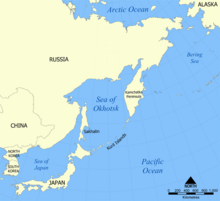| Canis lupus hattai | |
|---|---|

| |
| Taxidermied Ezo wolf at Hokkaido University Museum | |
| Scientific classification | |
| Domain: | Eukaryota |
| Kingdom: | Animalia |
| Phylum: | Chordata |
| Class: | Mammalia |
| Order: | Carnivora |
| Family: | Canidae |
| Genus: | Canis |
| Species: | |
| Subspecies: | †C. l. hattai
|
| Trinomial name | |
| †Canis lupus hattai | |

| |
| Range included Hokkaido and Sakhalin islands, the Kamchatka peninsula and Iturup and Kunashir islands just to the east of Hokkaido in the Kuril archipelago. | |
| Synonyms | |
|
C. l. rex (Pocock, 1935)[2] | |
The Hokkaido wolf (Canis lupus hattai), also known as the Ezo wolf (Japanese: エゾオオカミ(蝦夷狼)ー, Hepburn: Ezo Ōkami) and in Russia as the Sakhalin wolf,[3] is an extinct subspecies of gray wolf that once inhabited coastal northeast Asia. Its nearest relatives were the wolves of North America rather than Asia. It was exterminated in Hokkaido during the Meiji Restoration period, when American-style agricultural reforms incorporated the use of strychnine-laced baits to kill livestock predators.[4] Some taxonomists believe that it survived up until 1945 on the island of Sakhalin. It was one of two subspecies that were once found in the Japanese archipelago, the other being the Japanese wolf (C. l. hodophilax).
- ^ Kishida K (1931) Notes on the Yesso wolf, Lansania 3: 72–75
- ^ Pocock, R.I. The races of Canis lupus. Proc. Zool. Soc. London for 1935, pt. 3, pp. 647-686, pIs. 2. September 12, 1935. (New: Canis lupus rex, C. i. arctos, C. I. orion.) DOI: 10.1111/j.1096-3642.1935.tb01687.x
- ^ Heptner, V. G. & Naumov, N., P. (1998) Mammals of the Soviet Union Vol.II Part 1a, SIRENIA AND CARNIVORA (Sea cows; Wolves and Bears), Science Publishers, Inc., USA, pp. 193, ISBN 1-886106-81-9
- ^ Knight, John (1997). "On the Extinction of the Japanese Wolf". Asian Folklore Studies. 56 (1). Nanzan University: 129–159. doi:10.2307/1178791. JSTOR 1178791. Stable URL: https://www.jstor.org/stable/1178791
